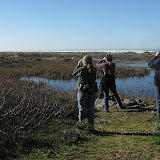Kaiseki a light meal served during a Japanese Tea gathering
Locavore one who dines upon food grown or produced close to home
Laura has been studying Chado for several years but had not yet enjoyed a formal Tea gathering, or
Chaji. She, along with friends Pia, John and Tony, joined us for a chaji in February in honor of her 50th birthday.
I've had no training other than working at the shoulder of my Sensei and Sempai, but I have an deep love and respect for what I believe is the epitome of locavore cuisine:
Kaiseki. In
cha-kaiseki -- kaiseki for the Tea ceremony -- the ingredients must be seasonal to reflect the theme the host has chosen for the Tea gathering. By extension, seasonal ingredients are fresh and grown locally or, at the least, regionally in California or the Pacific Northwest. (How on earth could something shipped halfway 'round the world be fresh?) Naturally, the best ingredients would be plucked from the garden that very morning.
Themes for Tea gatherings vary. Traditional Japanese holidays are common themes (such as New Year or Children's Day), but so is the observation of the turning of the seasons or simply honoring a guest. Take the spring equinox, for example. In late March, the weather might still be chilly, but we begin to anticipate the coming of warmer weather. Days lengthen. Migrating birds return home. Spring flowers are beginning to bloom. After the winter dearth of fresh vegetables, baby-fresh greens are coming to the market. The host selects spring-heralding flowers to decorate the Tea room, and utensils and a scroll will be chosen to also reflect this light and celebratory mood. Winter is finished, we celebrate
spring!
It follows, then, that the menu for a Tea gathering must also be in harmony with the theme, and so it was for Laura's birthday chaji. In February, we were still in the grip of winter but getting the first hints of spring and deciding on what to serve at the Chaji was a challenge. Humboldt County's forgiving climate gives us an embarrassing abundance of ingredients to choose from. We can have greens from the garden or ocean-fresh salmon pretty much year 'round. Failing that, several natural food stores offer regionally-grown produce, plus Farmer's Markets operate from May through November. Locavores have much to choose from, with the exception of grains (which some Hum Co farmers are now beginning to grow).
As far as we know, rice has yet to be cultivated on the Arcata Bottoms; that was an ingredient that needed an exception to the "local" rule. Same for the edamame, hijiki, sesame, tofu pouches and others, but many key ingredients were grown close to home. And close to our heart.
Laura's February Birthday Kaiseki Gohan -- plain white rice, cooked with a pinch of salt and a slice of kombu (kelp)
Misoshiru -- kombu dashi and a mix of red and white miso pastes (about 70%/30%), with simmered home-grown daikon topped with a dab of Sweet Mama Janisse's Sticky Love Sauce (a sweet mustard sauce manufactured in Humboldt County)
Muukozuke -- mixed sea greens with ginger and lemon zest
Sake #1 -- Momokawa Organic Ginjo Junmai (from Oregon)
Wanmori -- tofu pouches stuffed with seasoned portabello mushroom slice, hijiki and edamame, and tied with konbu; bamboo shoots, carrot, young broccoli and lemon zest garnish in a lightly thickened vegetarian broth
Yakimono -- tofu negi dengaku (tofu from Arcata's Tofu Shop grilled with Westbrae Soy miso dengaku sauce made with a generous amount of sauteed spring onions)
Azukebachi -- 1) simmered California-grown spinach seasoned with sesame dressing; 2) braised carrot and home-grown daikon with a creamy tofu dressing
Sake #2 -- Momokawa "Diamond"
Hashiarai -- seasoned lightly with umeboshi (pickled plum), lemon zest and a fresh plum blossomHassun -- 1) California asparagus seasoned with sesame; 2) "fans" of nori seasoned with miso sauce and lightly toasted
Omogashi -- daifuku (mochi and anko) freshly home-made by Annie (see "Microwave Mochi")Further readingThe Heart of Zen Cuisine, A 600-Year Tradition of Vegetarian Cooking. Soei Yoneda, Kodansha International, Tokyo and New York, 1982. Originally published as
Good Food from a Japanese Temple. Yoneda was the Abbess of Sanko-in Temple of Kyoto.
Kaiseki: Zen Tastes in Japanese Cooking. Kaichi Tsuji, Tankosha Press, Kyoto, 1972. Lovingly illustrated with original woodcuts and beautiful full-color photographs. Detailed notes seasonal foods, serving ware and preparation and arrangement of food.
Untangling My Chopsticks, A Culinary Sojourn in Kyoto. Victoria Abbot Riccardi, Broadway Books/Random House, New York, 2003. "As Victoria Riccardi goes in search of culinary enlightenment in this intimate and beautifully crafted memoir about living, cooking, and falling in love with Kyoto, the reader is seduced and transported by the scenes and flavors she paints with words. Riccardi writes with a sensuous eye for detail that brings alive the extraordinary beauty of Japan and the sumptuous pleasures of its table." --Lora Brody, author of
Growing Up on the Chocolate DietThe World in a Bowl of Tea, Healthy, Seasonal Foods Inspired by the Japanese Way of Tea. Bettina Vitelli, Harper Collins, New York, 1997.
North Coast Journal, selected articles about the Humboldt County local food movement and local grain farmers














